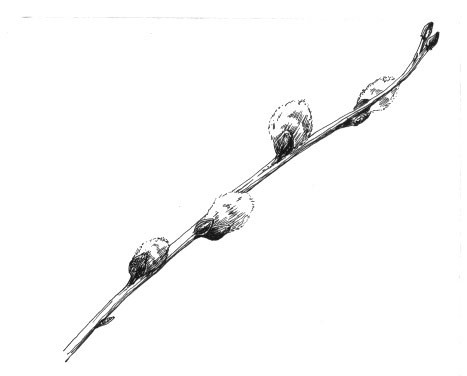
Soon after moving to Vermont 25 years ago, I began to hear a common lament, delivered with a slow shake of the head and a sigh of Yankee resignation. “There’s no springtime here. We go from winter right to summer, not like down south where spring lasts for months.”
While our vernal season does move quickly, spring stretches longer here than most people realize. Beyond the first steam that rises from sugaring shacks, the return of red-winged blackbirds, and the calls of wood frogs, there are subtle harbingers awaiting those who seek out our earliest blooms.
Pussy willows, those fuzzy forerunners of full flowers, are a welcome sight in the wetlands of April. A Native American story tells of a rabbit that jumped up into a willow shrub from atop the winter’s deepest snows. He was so exhausted from a day of leaping that he nestled in the crotch of a high branch and slept away the rest of the winter. The snows melted. When this Rabbit Van Winkle awoke and looked down from what was then a great height, he became dizzy and fell. As he plummeted, tiny bits of fuzz from his tail caught and tore off on the tips of each branch. Ever since that day, pussy willow flower buds have borne spring coats of fur.
Late snows and freezing rains often cover the outside of each willow bud’s jacket, which protects the growing flower parts within. When these flowers mature, they produce a bounty of mustard-colored pollen that is an important food for honeybees, moths, and other insects that buzz from bloom to bloom. These early spring visitors team up with the wind to help spread pollen at a time when there are no leaves to inhibit the breeze that blows through the branches.
If you notice little breaks in the snow cover where pussy willows grow, look for the thick, greenish brown cowling of skunk cabbage, with its purple splotches and veins. Inside the 3- to 6-inch-tall hood is a tight round cluster of flowers. As long as the air temperature is above freezing, this relative of the tropical philodendron and dieffenbachia can maintain a cozy 71.6°F (22°C) within its hood and actually melt its way through the snow. Small flies and honeybees use these heat islands to warm up on foraging flights.
Now grab a pair of binoculars to view another jewel of the plant world: wildflowers on high that sometimes emerge before the pussy willow. Focus up in the branches of silver maple to see its tiny flowers. In Vermont, I have recorded the appearance of the red female blooms and reddish yellow male flowers on the first day of April. A popular shade tree, silver maple grows naturally along the edges of wetlands and rivers. In mid-to-late April, when the flowers have gone by, their remnants fall as nondescript squiggly things that pile up on cars and sidewalks. Later in the summer, silver maple seeds detach and spiral down like small whirligigs.
As early as March 31st, American hazelnuts bloom beneath the filtered shade of hedgerows and in moist forests. The dangling male catkins are easy to find, but you’ll need to look backwards through your binoculars – using them as a hand lens – to explore the diminutive female blossoms of this delicate shrub whose petals shoot from the bud like a burst of floral fireworks. It takes three of these crimson beauties, stretched petal-to-petal, to reach across the face of a dime. These flowers will eventually form hazelnuts, or filberts. Young women of colonial America named individual filberts after men they were attracted to and then threw the nuts onto glowing embers. The one that blazed the highest was destined to become her “flame.”
Focus again in the treetops to see two of our earliest bloomers. The dangling, fuzzy flowers of popple (also poplar or aspen) precede the familiar quaking, pea-green leaves. I have seen several chunky ruffed grouse roost incongruously in the leafless crowns of aspen and feast on the delicate blooms. Each aspen tree, like holly and willow, bears either male or female flowers. Aspens can also propagate by root sprouts, and sometimes a grove spreads out from one parent tree to form a giant clone. Watch for the cottony tufts that drift down when the mature seeds begin to disperse.
A naturalist I know argues that all of these florid events take a back seat, in both timing and splendor, to the display of our beloved and embattled American elm, whose purplish flowers are among the most precocious. Whichever flower is your favorite, spring begins early and lasts long for anyone who takes the time to develop an eye for the intricate beauty of our first flowers of the season.

